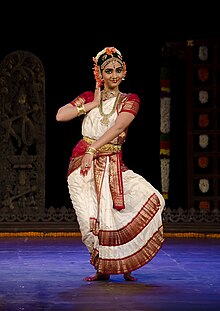 | |
| Native name | కూచిపూడి నృత్యం |
|---|---|
| Genre | Indian classical dance |
| Instrument(s) | |
| Origin | Kuchipudi, Krishna district, Andhra Pradesh |


| Part of a series on |
| Hinduism |
|---|
 |
Kuchipudi (/ˌkuːtʃɪˈpuːdi/ KOO-chih-POO-dee; Telugu: కూచిపూడి నృత్యం) is one of the eight major Indian classical dances.[2] It originates from a village named Kuchipudi in the Indian state of Andhra Pradesh.[3] Kuchipudi is a dance-drama performance, with its roots in the ancient Hindu Sanskrit text of Natya Shastra.[4][5][6] It developed as a religious art linked to traveling bards, temples and spiritual beliefs, like all major classical dances of India.[7]
Evidence of Kuchipudi's existence in an older version are found in copper inscriptions of the 10th century, and by the 15th century in texts such as the Machupalli Kaifat.[8][9] Kuchipudi tradition holds that Narahari Tirtha – a sanyassin of Dvaita Vedanta persuasion,[10] and his disciple, an orphan named Siddhendra Yogi, founded and systematized the modern version of Kuchipudi in the 17th century.[11][12][13] Kuchipudi largely developed as a Krishna-oriented Vaishnavism tradition,[14] and it is known by the name of Bhagavata Mela in Thanjavur.[8]
The traditional Kuchipudi was performed by all males troupe. A dancer in a male role would be in Agnivastra, also known as Bagalbandi, wear a dhoti (a single pleated piece of cloth hanging down from the waist).[15][16] A dancer in a female role would wear a Sari with light makeup.[16] The Kuchipudi performance usually begins with an invocation. Then, each costumed actor is introduced, their role stated, and they then perform a short preliminary dance set to music (dharavu). Next, the performance presents pure dance (nritta).[17] This is followed with by the expressive part of the performance (nritya), where rhythmic hand gestures help convey the story.[17][18] Vocal and instrumental Carnatic music in the Telugu language accompanies the performance.[19] The typical musical instruments in Kuchipudi are mridangam, cymbals, veena, flute and the tambura.[20] The popularity of Kuchipudi has grown within India and it is performed worldwide.[21][22]
- ^ Sunil Kothari & Avinash Pasricha 2001, p. 117.
- ^ Williams 2004, pp. 83–84, the other major classical Indian dances are: Kathak, Odissi, Bharatanatyam, Kathakali, Manipuri, Chhau, Satriya, Kuchipudi and Mohiniyattam..
- ^ "'Art has to be nurtured to sustain'". The Hindu. Retrieved 5 April 2017.
- ^ Cite error: The named reference
Varadpande1982p133was invoked but never defined (see the help page). - ^ Ragini Devi 1990, pp. 60–68.
- ^ Sunil Kothari & Avinash Pasricha 2001, pp. 43–46, 80 footnote 8.
- ^ James G. Lochtefeld (2002). The Illustrated Encyclopedia of Hinduism: A-M. The Rosen Publishing Group. pp. 376–377. ISBN 978-0-8239-3179-8.
- ^ a b Reginald Massey 2004, pp. 79–81.
- ^ Ragini Devi 1990, pp. 67–68.
- ^ Krishna Chaitanya (1987), "Arts of India.", pages.74
- ^ Ragini Devi 1990, p. 73.
- ^ Banham, edited by James R. Brandon ; advisory editor, Martin (1993). The Cambridge guide to Asian theatre (Pbk. ed.). Cambridge, England: Cambridge University Press. p. 96. ISBN 978-0-521-58822-5.
{{cite book}}:|first=has generic name (help)CS1 maint: multiple names: authors list (link) - ^ Sunil Kothari & Avinash Pasricha 2001.
- ^ Farley P. Richmond, Darius L. Swann & Phillip B. Zarrilli 1993, p. 173.
- ^ Cite error: The named reference
NettlStone1998p516was invoked but never defined (see the help page). - ^ a b Cite error: The named reference
Narayan2011p50was invoked but never defined (see the help page). - ^ a b Sunil Kothari & Avinash Pasricha 2001, pp. 43–45, 97–104, 117–121.
- ^ Cornelia Müller (2013). Body – Language – Communication. De Gruyter. pp. 310–319. ISBN 978-3-11-026131-8.
- ^ Sunil Kothari & Avinash Pasricha 2001, pp. 147–149.
- ^ Farley P. Richmond, Darius L. Swann & Phillip B. Zarrilli 1993, pp. 172–173.
- ^ Ragini Devi 1990, pp. 73–76.
- ^ Cite error: The named reference
Oonk2007p109was invoked but never defined (see the help page).